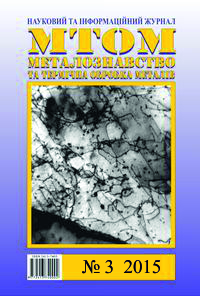About structure-forming role of composite nanomaterials
Keywords:
composite materials, carbon nanostructures, nanomaterials, structure, properties, metalAbstract
Raising of problem. The development of modern science and technology places high demands on the materials of the structural and functional applications. Significant progress in this area has been achieved with the development of composite materials (CM) on the basis of metals, polymers construction of cement and gypsum binders. The most widely used metal-KM-reinforced high-modulus reinforcing particles, fibers, whiskers. Compared with conventional alloys KM based on them have higher values of specific strength and stiffness, while maintaining or slightly reducing electrical and thermal conductivity, which gives them a competitive advantage in a number of fields of science and technology. Despite the growing interest in the nanocomposites based on various reinforced carbon nanostructures (СNS), systematic research and subsequent technological solutions in this area is not enough. This is due to the novelty of the problem, namely the fact that the methods of treatment of nanomaterials - control the size, structure, phase composition, surface condition, etc. They are in the process of accumulation of basic knowledge. Thus, the development of methods for obtaining the CM, СNS strengthened, and the study of their structure and properties is an important task, representing the scientific and practical interest. Purpose - obtaining carbon nanomaterials predetermined morphology and structure for their preparation for the subsequent application in composite materials. Conclusion. Within the framework of a single material, methodological and instrument base, the processes of structure formation of the Cabinet, held comprehensive comparative study of the structure and mechanical properties of the CM.
References
Laplaze D. Carbon nanotubes : the solar approach / D. Laplaze,
P. Bernier, W.K. Maser and etc. // Carbon, 1998, vol. 36, no. 5-6,
pp. 685-688.
Rodriguez N.M. A review of catalytically grown carbon nanofibers / N.M. Rodriguez // J. Mater. Res, 1993, vol. 8, no 12, pp. 3233-3250.
Кечин В. А. Основные тенденции создания наноструктурированных материалов / В. А. Кечин, В. Е. Ваганов // Металлургия и машиностроение. – 2010. – № 2. – С. 27-30.
Kechin V.A. and Vaganov V.E. Osnovnyye tendentsii sozdaniya nanostrukturirovannykh materialov [Main tendencies of creating nanostructured materials]. Metallurgiya i mashinostroenie [Metallurgy and mechanical engineering]. 2010, no. 2, pp. 27-30. (in Russian).
Koyama T. Formation of Carbon Fibers from Benzene / T. Koyama // Carbon, 1972, vol. 10, no. 6, pp. 757-758.
Baird T. Carbon Formation on Iron and Nickel Foils by Hydrocarbon Pyrolysis—Reactions at 700 °C / T. Baird, J.R. Fryer and B. Grant // Carbon, 1974, vol. 12, no. 5, pp. 591-602.
Oberlin A. Filamentous growth of carbon through benzene decomposition / A. Oberlin, M. Endo and T. Koyama // J. of Crystal Growth, 1976, vol. 32, pp. 335-349.
Tibbets G.G. Carbon fibers produced by pyrolysis of natural gas in stainless steel tubes / G.G. Tibbets // Appl. Phys. Lett., 1983, vol. 42,
pp. 666-667.
G.G. Tibbets, Why Are Carbon Filaments Tubular/ G.G. Tibbets // Appl. Phys. Lett., 1984, vol. 66, pp. 632.
Endo M. Formation of carbon nanofibers / M. Endo, H.W. Kroto //
J. Phys. Chem., 1992, vol. 96, pp. 6941-6944.
Charlier J.C. Microscopic growth mechanisms for carbon nanotubes / J.C. Charlier, A. De Vita, X. Blasé and etc. // Science, 1997, vol. 275,
pp. 646-649.
Dai H. Probing electrical transport in nanomaterials: Conductivity of individual carbon nanotubes / H. Dai, E.W. Wong and C.M. Lieber // Science, 1996, vol. 272, pp. 523-526.
Шибаев Д. А. Химическая модификация углеродных нанотрубок / Д. А. Шибаев, В. Ю. Орлов, Д. А. Базлов, В. Е. Ваганов // Известия вузов. Серия «Химия и химические технологии». – 2011. – Т. 54. – № 7. – С. 38-41.
Shibaev D.A, Orlov V.Yu., Bazlov D.A. and Vaganov V.E. Khimicheskaya modifikatsiya uglerodnykh nanotrubok [Chemical modification of carbon nanotubes]. Izvestiya vuzov. Seriya «Himiya i himicheskie tehnologii» [Proceedings of the universities. A series of "Chemistry and chemical technology]. 2011, vol. 54, no. 7, pp. 38-41. (in Russian).
Ваганов В. Е. Влияние углеродсодержащих наноструктур на оптические и физические свойства материалов, включая жидкие кристаллы / Н. В. Каманина, В. Е. Ваганов // Жидкие кристаллы. – 2010. – № 2. – С. 5-24.
Kamanina N.V. and Vaganov V.E. Vliyaniye uglerod-soderzhashchikh nanostruktur na opticheskiye i fizicheskiye svoystva materialov vklyuchaya zhidkiye kristally [Influence of carbon-containing nanostructures in the optical and physical properties of materials including liquid crystals]. Zhidkie kristally [Liquid Crystals], 2010, no. 2, pp. 5-24. (in Russian).

Downloads
Published
Issue
Section
License
Authors that are published in this journal agree to follow the conditions:
Authors reserve the right to the authorship of his work and cede the right to the journal of first publication of this work on conditions of the license under the Creative Commons Attribution License, which allows others to distribute it freely with the obligatory reference to the author of the original work and the first publication of the work in this journal.
